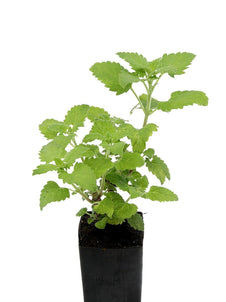
Catnip Lemon
Catnip Lemon

- In stock, ready to ship
- Inventory on the way

Usually available: All year
Life cycle: Perennial
Height: 90cm - 1.4m
Position: Sun / part shade
Soil preference: Well drained
This is how we pack and send your Herb Plants to all states except TAS & WA
You will receive
- 1 Catnip Lemon Herb Plant in a 50 X 75mm tube - General growing instructions
All of our Herb Plants are grown organically with certified organic potting mixes and fertilizers
Botanical Name:Nepeta cataria 'citriodora'
Catnip is a large family of perennial plants from the mint family, growing in a range from 90cm – 1.4 meters. Lemon Catnip is very similar to the more common Catnip plant and is considered to be a sister plant. This variety should reach a height and width of 90cm by 90cm. In summer it has small white flowers with a purple hue and occasionally purple spots, as found on common catmint, will appear. The leaves are an oval shape, often with a limey grey colour, tending towards green. The square shaped stems are straight with triangular to ovate leaves. The aroma is complex with a citrus quality to the minty base fragrance. The new growth is highly scented.
There is approximately 250 species of plant in the Lamiaceace family, collectively known as the ‘catnips’. The genus, Nepeta, takes its reference from an ancient Etruscan city called Nepete. Most are perennials, with a range from 30cm to over a meter high in their ideal environment. The family of catnip herbs are native to Europe, Africa and South West Central Asia, and have been naturalised to North America. Some are cultivated as ornamentals and are good bird, bee and butterfly attractants.
Growing Conditions
Lemon Catnip is quite happy in dry soils and is good to grow in difficult dry areas of the garden. The best position is full sun, but some shade is tolerated and watering should be moderate under hot conditions. Fertilising is not recommended unless the soil is very poor, because it will encourage leaf growth at the expense of flowering.
Nepeta citriodoria is easy to grow and should survive normal winter conditions in an outdoor environment. However, it is small enough to plant in containers and this may enable some protection in more frost prone areas. After summer blooming is complete, the plant can be cut back to promote another round of flowering. Pinching out the stems may also keep the plant more bushy and compact.
Lemon Catnip is easy to propagate from seed, taking approximately 5-7 weeks to flower once it has germinated. The seed may be sewn in late winter or spring after the frost risk has passed. Alternatively, the plant may be lifted and divided in spring to enable propagation. It is recommended to use rotted organic matter when replanting to help establish new plants.
Medicinal Uses
Catnip is a very old plant with a long history of medicinal uses and other applications such as herbal teas. It was used as a tranquiliser in Ancient Rome and Lemon Catnip has similar qualities. For further information please see Catnip (Nepeta cataria).
Other Uses
Catnip is a good natural insecticide and is known for its effect on the behaviour of cats. There is more information in the Catnip description.
All information provided on this website is for informational purposes only. Please seek professional advice before commencing any treatment.





